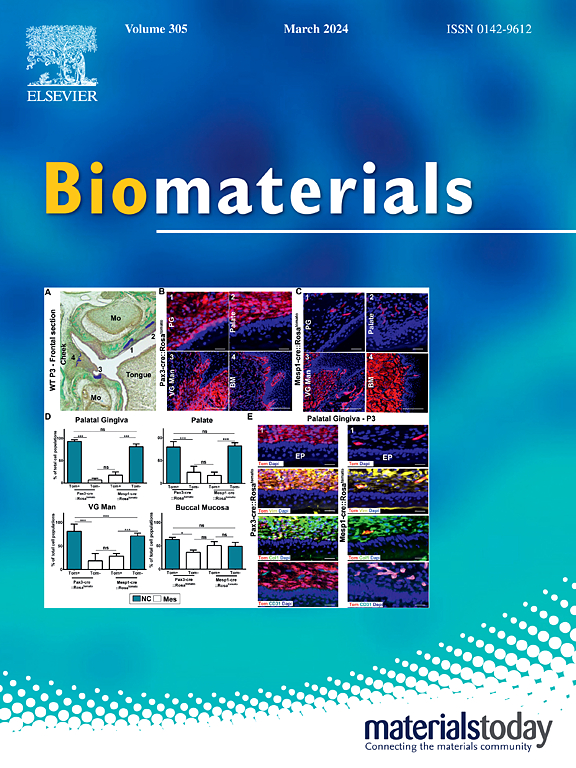Biomaterial-based therapeutic strategies for inflammatory bowel disease
IF 12.9
1区 医学
Q1 ENGINEERING, BIOMEDICAL
引用次数: 0
Abstract
Inflammatory bowel disease (IBD) is a chronic, challenging condition characterized by epithelial barrier disruption, immune dysregulation, and alterations in gut microbiota, leading to symptoms such as abdominal pain, diarrhea, and weight loss, affecting millions of patients worldwide. The etiology and pathogenesis of IBD are multifactorial, involving a combination of genetic factors, environmental influences, microbial dysbiosis, and other elements. Current treatments for IBD include aminosalicylates, antibiotics, corticosteroids, and immunosuppressants, all aimed at reducing inflammation and achieving clinical remission. However, the frequent and prolonged use of these medications results in significant adverse effects, including joint pain, diabetes, and osteoporosis. Therefore, targeting drug delivery to affected areas, extending the duration of drug action, and minimizing systemic exposure are crucial for effective IBD management. Emerging strategies that target excess reactive oxygen species, modulate local inflammation, and restore gut microbiota homeostasis show promise for improving IBD treatment. Biomaterials have demonstrated considerable potential in precisely delivering therapeutic agents selectively to inflamed tissues, thereby minimizing off-target effects and improving efficacy. This review highlights recent advancements in biomaterials for IBD treatment and explores future directions and challenges in their clinical application.

基于生物材料的炎症性肠病治疗策略
炎症性肠病(IBD)是一种慢性、具有挑战性的疾病,其特征是上皮屏障破坏、免疫失调和肠道微生物群改变,导致腹痛、腹泻和体重减轻等症状,影响全球数百万患者。IBD的病因和发病机制是多因素的,涉及遗传因素、环境影响、微生物生态失调等因素的综合。目前IBD的治疗方法包括氨基水杨酸、抗生素、皮质类固醇和免疫抑制剂,所有这些都旨在减少炎症和实现临床缓解。然而,频繁和长期使用这些药物会导致严重的不良反应,包括关节疼痛、糖尿病和骨质疏松症。因此,靶向药物递送到受影响的区域,延长药物作用的持续时间,并尽量减少全身暴露对于有效的IBD管理至关重要。针对过量活性氧、调节局部炎症和恢复肠道微生物群稳态的新策略有望改善IBD的治疗。生物材料已经显示出相当大的潜力,可以选择性地将治疗剂精确地输送到炎症组织,从而最大限度地减少脱靶效应并提高疗效。本文综述了生物材料治疗IBD的最新进展,并探讨了其临床应用的未来方向和挑战。
本文章由计算机程序翻译,如有差异,请以英文原文为准。
求助全文
约1分钟内获得全文
求助全文
来源期刊

Biomaterials
工程技术-材料科学:生物材料
CiteScore
26.00
自引率
2.90%
发文量
565
审稿时长
46 days
期刊介绍:
Biomaterials is an international journal covering the science and clinical application of biomaterials. A biomaterial is now defined as a substance that has been engineered to take a form which, alone or as part of a complex system, is used to direct, by control of interactions with components of living systems, the course of any therapeutic or diagnostic procedure. It is the aim of the journal to provide a peer-reviewed forum for the publication of original papers and authoritative review and opinion papers dealing with the most important issues facing the use of biomaterials in clinical practice. The scope of the journal covers the wide range of physical, biological and chemical sciences that underpin the design of biomaterials and the clinical disciplines in which they are used. These sciences include polymer synthesis and characterization, drug and gene vector design, the biology of the host response, immunology and toxicology and self assembly at the nanoscale. Clinical applications include the therapies of medical technology and regenerative medicine in all clinical disciplines, and diagnostic systems that reply on innovative contrast and sensing agents. The journal is relevant to areas such as cancer diagnosis and therapy, implantable devices, drug delivery systems, gene vectors, bionanotechnology and tissue engineering.
 求助内容:
求助内容: 应助结果提醒方式:
应助结果提醒方式:


